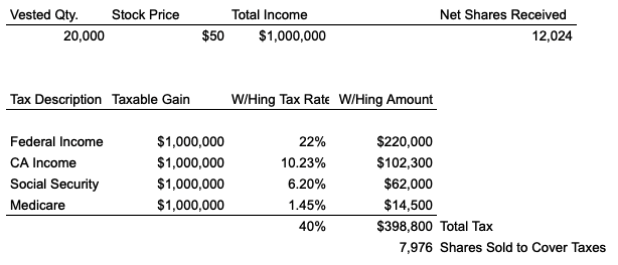The Reddit IPO is here! What does that mean for you as a Reddit employee?
Prepare for what is coming:
When can you do something with your stock?
How should you prepare before the Reddit IPO?
What should you consider at Reddit’s IPO?
What does it really mean for you post-IPO?
Should I use a Donor Advised Fund for charitable giving?
During the holidays, giving is on the mind. Who should you give charitably to? How much should you give? What is the best way to give?
If you want a tax efficient way to set up long term giving, a Donor Advised Fund (‘DAF’) may be for you.
How do Donor Advised Funds work?
Donor Advised Funds (‘DAFs’) are a way to donate cash, stock, etc now to support charitable causes later. A Donor-Advised Fund is an account that you can make a contribution to and qualify for a tax-deductible charitable donation. Once you contribute the funds, you cannot take money out of the account for non-charitable purposes later.
Donor Advised Funds stay in the account until you are ready to give funds to a qualified public charity (even years later). However, Donor Advised Funds aren’t for everyone.
When should you use a donor-advised fund?
For our tech professional clients, this may look like donating company stock they’ve held for a long time to a Donor Advised Fund. Or setting up a Donor Advised Fund at a company exit to help with long term giving. This sets them up for the tax benefits of a Donor Advised Fund that then grows tax free for supporting future charitable endeavors.
The top reasons to use a Donor Advised Fund are:
- The tax benefits in donating highly-appreciated stock
- The strategy of ‘bunching’ charitable contributions for a tax deduction
- Planning during a company exit (Merger, acquisition, or IPO)
- Investing the funds to grow tax-free for future charitable giving
What are the tax benefits of a Donor Advised Fund?
The tax benefits of a DAF are threefold:
1. You can give cash, stock, or other complex assets (land, etc). You can transfer over low cost basis assets without paying the tax on unrealized capital gains. If you had to sell the stock or asset to make a donation, you’d pay taxes and potentially have less to give in cash. With a stock or asset transfer, you give the fair market value of the contribution without additional tax consequences.
2. You get an immediate year charitable deduction for your contribution to a DAF. This means you can take your higher income years to make a larger DAF contribution that can be used over many years.
3. You have the opportunity to invest the donation in stock investments to grow tax-free until you are ready to give funds to a charity. Since the funds are already in the DAF account, any stock sales won’t count against your personal tax return.
Bunching charitable contributions for a tax deduction
Do you give $10,000 a year towards charities and still take the standard deduction on your tax return? If you are able to contribute more to a DAF every few years, you may be eligible for a bigger tax deduction for the year.
There is no contribution limit on how much you may donate to a Donor Advised Fund..
This can help you plan your charitable contributions a bit more beyond giving to charities through the year. You could decide to contribute two year’s worth of charitable funds to make sure each dollar counts towards a deduction on your tax return.
Matching a high income year with a larger DAF contribution
Another strategy is to make a contribution the same year as your company exit. If you have stock compensation at a smaller tech company and own shares, this may me a good time for a DAF. When income is very high, a charitable contribution to a Donor Advised Fund could set up your giving over the rest of a lifetime. At SeedSafe Financial, we understand your charitable giving goals, any flexibility needed for the funds, and make a discounted cash flow analysis to know what amount may work well for a contribution.
You may reach a level where you are over the threshold for a current year’s itemized deduction on your tax return. Any charitable contribution more than the limit will carry forward for up to 5 years. For 2023, the general limit on charitable contributions to DAFs is 50% of adjusted gross income.
Ease to open, low cost to grow, and streamline your giving
Donor Advised Funds are as quick to open as other brokerage investment accounts. You can be up and running within minutes on sites like Schwab Charitable, Fidelity Charitable, and CharityVest.
You can choose to invest all or part of your funds in the DAF account. Your contribution should be invested based on your charitable giving goals. Are you hoping to use this account primarily for giving in retirement, over your lifespan, or in the next few years? The risk you may be comfortable taking in each of those situations could differ. Growth from investing the funds in the account will be tax-free.
Most Donor Advised Funds offer a low cost mix of ETFs or model portfolios to choose from. This helps streamline your investment strategy while you decide how you want to give the funds over time.
How does it work to send funds to charities from the Donor Advised Fund?
Giving funds to a charity through the Donor Advised Fund is called a ‘grant’. Qualified grants are generally to public 501(c)(3) charities. The IRS has a search tool for you to review what organizations meet this requirement on their website (HERE). The DAF providers may differ in the process of distributions to charities and may have a minimum grant size requirement. When reviewing DAF providers, it is important to know how and when you want to use the funds so you can pick the best option for you.
In the end, a Donor Advised Fund works best for higher-income earners or those with large gains sitting in their taxable investments. How much to contribute is based on what your hopes are for charitable giving. We recommend reviewing this strategy with a tax professional or financial planner. Especially if you are considering donating exercised incentive stock options.
Looking for a financial planner and CPA? Schedule some time with us to chat and learn more about our services.
The above discussion is for informational purposes only. Recommendations are of a general nature, not based on knowledge of any individual’s specific needs or circumstances, and there is no intent to provide individual investment advisory, supervisory or management services.
Should I choose the HDHP or PPO from my company’s benefits?
Benefits enrollment season is upon us again and we often review if a HDHP or PPO makes more sense…it depends!
What health insurance is best for you depends on a few things:
- Your current health and how often you see a doctor,
- Whether you have extra cash to pay for medical costs, and
- If you feel you can emotionally take that risk
What are the terms to know when evaluating a HDHP vs PPO?
PPO – a ‘preferred provider organization’ gives you more in-network options for providers (doctors, medical offices, etc) than other plans may have. You also do not need a referral from your primary doctor for most specialists.
HDHP – a ‘high deductible health plan’ can actually be a PPO – the main difference is that it meets certain IRS requirements to qualify for adding an HSA ‘health savings account’. These plans typically have lower premiums but higher out-of-pocket costs.
Deductible – The cash you put towards doctors visits, prescriptions, etc before your health insurance pays the provider in full.
For PPOs, there is often a per visit and per medication amount you pay (‘copay’) up to the total deductible amount
For HDHPs, you generally pay the full cost of visits, care, and prescriptions until you reach the total deductible
Out-of-pocket maximum – the amount you pay before the health insurance company covers additional needs. Each insurance plan is different. The out-of-pocket amount is higher than the deductible and includes additional prescription payments, hospital visits, etc up to a certain dollar amount.
Premiums – your contribution from your paychecks to your health insurance plan
In-network vs out-of-network – In-network services are at a negotiated price with the health insurance plan. Out-of-network providers do not have a contract with the health insurance plan. Your out-of-network maximum cash out-of-pocket amount is generally much higher.
Is it better to have a PPO or HDHP?
This depends on your plans available. Review your summary of benefits in your enrollment package to understand insurer choices, premium cost, deductible, and out-of-pocket maximum.
Then, review each type of care listed to understand how the PPO or HDHP may cover each of those needs. Often you will see a lower copay and deductible for PPO plans but a higher premium.
The basic trade off is: a higher premium means lower costs for each care need. A lower premium means a higher out-of-pocket contribution.
So why would you choose a lower premium?
One reason may be if you are in good health and rarely see a doctor. You may choose to take the risk of not paying for health care services if you believe you won’t need many.
For higher-income earners, the reason may be to participate in the HSA ‘health savings account’.
What is a HSA ‘health savings account’?
An HSA ‘health savings account’ allows you to make pre-tax contributions to an account and make tax-free distributions from it to pay for qualified health insurance costs. What you do not use within the year will continue to remain in the account for future use. This beneficial treatment is limited to $8,300 for a family/$4,150 for an individual in 2024. For employees over age 55, there is an additional $1,000 catch up contribution available.
For high-income earners, this may mean saving 37%+payroll taxes on contributions to an HSA account or ±$3,500 a year! *Note, states like California may add the HSA back to taxable income. Federal, it will be a pre-tax benefit
What makes HSA accounts even more attractive is when an employer makes a contribution (free money!) or you are able to allow the HSA contributions to accumulate in the account. Most HSA accounts allow you to further invest what is in your account. This means these investments can continue to grow over time for future needs.
We know an HSA account allows tax-free distributions for qualified medical costs. It can also grow until you reach 59 ½+, then it can also be used for retirement expenses like an IRA or 401(k).
This makes the HSA account a triple threat for high income earners:
- A current pre-tax contribution
- Ability to pay for qualified medical costs tax-free, and
- Grow the account with investments long term for retirement
What is an FSA ‘flexible spending account’?
An FSA is another account that allows you to make pre-tax contributions for medical expenses you may have in a given year. This account is generally paired with the PPO and is limited to $3,050 in contributions in 2024. The downside is, if you don’t use it, you lose it! So you may decide not to max out this account and only put in what you believe you will need for the year. Some companies allow a grace period into the following year – but not longer than the first 3 months.
Example of a PPO vs HDHP
Annually, we do a review of our clients’ enrollment benefits to understand what is changing and review the available options. This tends to include an analysis of whether a PPO or HDHP may make more sense for them.
Let’s use the example of a family at the 35% tax bracket in income and the employee is 47 years old. They have excess cash above their expenses each month to use towards medical expenses and maximizing a contribution to an HSA. Their company provides a $1,000 family contribution to the HSA account. At this point, they tend to go to the doctor around 10 times a year and need a few prescriptions as things pop up.
First, we gather information on their deductible, out-of-pocket maximum, and premiums. Then, we talk through available health insurers and whether their current doctors would be considered in-network. If we feel pretty good about the information given, we will create a calculation to understand what the net after-tax cost of each option may be.
In this example we are looking at the tax savings and cash outlays of what are involved under each situation. The actual calculation for you may be very different, but in this example the HDHP means a current year benefit of $2,039 for the family.
This doesn’t include any long-term growth of allowing the HSA contribution to be invested and untouched for 12+ years.
When does a HDHP not make sense?
There is still a risk that your medical care needs are greater than expected or that you need out-of-network health care. If you travel often and enjoy riskier activities, then that may mean a higher likelihood that the savings of a HDHP do not materialize for you.
It also may not make sense if you do not have the cash available to maximize the HSA and pay for your medical expenses out of pocket.
Reviewing your benefits package is about making your best assessment. You can always change your mind with the next enrollment season 🙂
Did you enjoy reading this article? Join our newsletter to be notified when new posts are available.
The above discussion is for informational purposes only. Recommendations are of a general nature, not based on knowledge of any individual’s specific needs or circumstances, and there is no intent to provide individual investment advisory, supervisory or management services.
What tax election should I make at an IPO?
If you have double trigger RSUs and an IPO coming up, you may receive a ‘tax election’ from your company. This tax election allows you to decide how much you want to have set aside for taxes on your vesting RSUs at the time of IPO.
For the purposes of this conversation, we will hit on why you might want to choose one tax withholding option over another.
Why do I need to make a tax election at an IPO?
Remember, tax withholding ≠ taxes due. Tax withholding is a required high-level estimate of taxes that needs to be paid into the IRS throughout the year. Even if it feels like you’ve paid a lot in tax withholding, you may still owe more at tax time.
Do you want a refresher on double trigger RSUs and an example of the tax breakdown? Check out our post What are Double Trigger RSUs and how are they treated?
Should I choose to withhold 22% or 37% in Federal taxes from my IPO vesting?
It depends. How much you withhold for taxes depends on how you want to think about your stock and what your total income for the year will be.
Some individuals view 37% withholding as ‘leaving gains on the table’ for shares that *could have* appreciated. Some individuals view 22% as being a big risk that they may have to sell more shares to cover a tax bill if the stock price goes down.
We encourage you to consider this using examples of what that risk might be for your own situation.
Examples of taxes at an IPO
Let’s choose two situations. The first scenario is for Greg and the second scenario is for Alexa. We assume that both Greg and Alexa have families and are expecting an IPO to happen at year end. This IPO will help them each with buying their next home and getting closer to financial independence. The biggest difference between them is that Greg started at the company as an IC and Alexa came on as a Director. What could their taxes look like?

By estimating what their total income for the year will be and the taxes due, we can get an idea of what their estimated tax load (aka ‘effective tax rate’ may be).
Other considerations for estimating taxes
Some bigger pieces we are leaving out of these examples are:
If your salary is low, chances are your withholding on your salary is much lower than needed at the IPO. Salary withholding tables were made by the IRS assuming your salary is your main income. It matches tax withholding requirements with that income expectation. If both spouses are working, this effect is magnified.
If you have ISOs or NQSOs to consider, the math gets way more complex. We recommend working with your tax advisor or financial planner to create the best strategy for you.
Other sources of income may change the math as well. If you do consulting on the side, have other IPOs in the same year (yes, this has happened to our clients in the past!), or long term rentals, then you will need to up your estimate.
Now let’s see how the 22% and 37% tax withholding election could work out for them.
Examples at 22% tax withholding
This is where total estimated income and the effective tax rate matter. Let’s break down the withholding made a bit further between salary and the RSUs vesting at an IPO.

In this case, the difference in total income makes a huge difference in how much more they will still owe come tax time. Greg may view the risk of $10,000 needed in cash to cover the shortfall as ‘worth the risk’ or up his withholding in case the stock price drops. Alexa’s shortfall could be catastrophic if she isn’t ready to pay $200,000 at tax time.
What are the downsides to taking on the risk of lower tax withholding?
This comes down to what you can afford to take risk wise and what you can’t. Greg may have $10,000+ in cash savings annually and see this as a high risk/high reward worth electing the lower 22% tax withholding for.
Alexa may not have $200,000 laying on the sidelines to pay her taxes with. Even more importantly, what if she did??
Each IPOing employee in this situation should ask themselves:
1. If you sell more for withholding now and it goes up, how would you feel?
2. If you don’t sell enough to cover taxes now and it goes down, how would you feel?
In Alexa’s case, how would she feel paying $200,000 in to cover taxes only to see the stock tumble? If the answer is 🙁, then Alexa should select 37% withholding.
Another consideration is the lockup period. Most IPOing companies have a 180 day lockup period (with some caveats). I don’t have data on how IPOs tend to look 6 months out, but there is a great study at NASDAQ on what happens to IPOs over the long run. Long term, the majority of IPOs do not perform well and drop below their IPO price. This is something to consider in your risk assessment.
Examples at 37% tax withholding
What would happen in each of these scenarios at 37% withholding? Each would end up with a refund after filing their taxes.

I like to think of this as selling some shares at the IPO price – because that is effectively what will happen. 🙂
Through these two examples, you now have an idea of what a 22% tax withholding rate vs 37% tax withholding rate might mean for you. The important thing is that you know what to expect – uncertainty and big tax bill surprises can take the fun out of your Company’s IPO.
Interested in learning more? Sign up for our newsletter
The above discussion is for informational purposes only. Recommendations are of a general nature, not based on knowledge of any individual’s specific needs or circumstances, and there is no intent to provide individual investment advisory, supervisory or management services.
What are Double Trigger RSUs and how are they treated?
Double trigger RSUs are a popular type of stock compensation leading up to an IPO. They are better for the employer – who doesn’t need to recognize stock expenses until IPO. They are less mental energy for the employee – who doesn’t have to pay taxes or make sell decisions until IPO.
What is the difference between single-trigger and double trigger RSUs?
How does double trigger vesting work?
What happens to a double trigger RSU at an IPO?
Does my company pay my taxes on the double trigger RSUs at vest?
What is an example of taxes on a double trigger RSU?
Here’s an example of what it might look like.

When double trigger RSUs vest, you will want to make sure you account for this as you decide what to do with the shares.
Do I owe taxes on my double trigger RSUs if I hold onto them after the IPO?
Do I owe taxes on my double trigger RSUs if I sell them after IPO?
What happens to a double trigger RSU if you leave?
- If you have double trigger RSUs that are not time vested, those will expire immediately.
- If you have double trigger RSUs that did meet the time vesting component, it may depend more on whether termination was ‘for Cause’.
- In this case, ‘for Cause’ termination may result in complete termination. ‘Not for Cause’ termination is gentler and usually allows you to be eligible for the time vested RSUs to vest at IPO or exit.
What should I do if my startup announces a tender offer?
What does it mean for my startup to have a tender offer?
A tender offer is a startup’s way of providing liquidity to employees and offering shares to others. Often we see this start to happen as the company gets closer to IPO or decides to delay IPO. In part, this helps employees see the value of their hard work and in part helps the company provide stock to potential investors.
Generally, we see startup tender offers limited to a maximum of $X or Y% per person. The more common caps we’ve seen are up to $1 million in value or 50% of stock outstanding. This is because tender offers are generally fueled by investor money or profits and so there is a total cap. If the tender offer is ‘oversubscribed’, that means there is more demand for tendering shares for cash than can be fulfilled. In this case, your total request of shares to be bought back may be further limited.
Review your personal financial situation to decide whether participating in the tender offer is right for you.
- Are you hoping to buy a new home?
- Are you expanding your family and want to get a head start on college funding?
- Will you be leaving the startup soon and need to plan for a potential clawback?
- Do you want to exercise more stock options and are facing a cash crunch?
- Do you want to diversify out of your startup stock a bit for future flexibility?
There are many opportunities in selling back some shares in a startup tender offer. Other questions can be found in our tender offer basics post.
What should I consider during a tender offer?
- Why is the company doing a tender offer? Is this an opportunity for investors to get in when they believe the stock is undervalued? Or is this to provide liquidity while waiting for IPO/M&A?
- What is the valuation the shares are being offered at? If the shares are ‘underwater’ i.e. under the exercise price for options or RSU vesting price, you may feel differently about tendering the options. Generally, there is no reason to tender stock options under the exercise price.
- How do I feel my company is doing? Are you surprised at the valuation? Do you see a long road ahead for the company? Or do you feel the company is at a lower point now with the right metrics to get it to an even better Series XYZ in a year or two? Although your assessment is biased, it is something to consider and weigh the risk / reward of keeping more shares. I like to ask the question as: If you had the value of what you expect from the tender offer in cash, would you buy company stock with it?
- What are the tax implications? Each type of stock option and currently held share may have different tax implications in a tender offer.
- Which experts are in my corner to make sure I am considering the implications? Consult with your financial advisor or tax advisor to plan for the best outcome. If you are looking for guidance, schedule some time with us to think through options HERE.
What are the tax implications in tendering my shares?
- Unexercised stock options: the difference between the sales price and exercise price will be treated as ordinary income (compensation)
- Exercised ISOs:
- If held short term or less than 2 years from grant date, this would disqualify the special tax treatment and turn it into an NQSO sale. We rarely recommend doing this since you may have already paid AMT taxes at exercise and will not be able to get a credit back. This will be treated as ordinary income (compensation)
- If held long term, this will result in long term capital gains/losses
- Exercised NQSOs: short term or long term capital gains/losses
- Vested RSUs: short term or long term capital gains/losses
- Unvested RSUs: these are generally ineligible for tendering
Beyond what type of income or gains/losses each type of stock will be, there is also the question of who is paying any taxes due to the IRS and state tax department. We suggest reviewing your paystub post-tender offer to see what came through the paystub vs. what did not. You will be liable for the taxes in the end, so it is better to know now than when you file your tax return.
Is a tender offer better than an IPO?
Startup tender offers can be rewarding and less stressful. Instead of watching the market daily while you wait out your lock up period, a tender offer allows you to review your finances with a known price. It is a great way to financially profit while waiting for an IPO or Merger to happen “one day”.
I love it when a long-time startup employee comes to us with RSUs and ISOs in a tender offer. Then, we work together to find the best strategy based on their situation. Our goal is to understand where you want to be financially and keep it front in center. Then, we balance tax implications, risk exposure, and long term growth at a level you are comfortable with.
For many of our clients going through tender offers with RSUs and ISOs we are able to purchase ISOs, minimize AMT taxes and diversifying out a large portion of cash from the event. This makes my heart sing for my clients!
Can a startup force a repurchase of shares?
This is often called a ‘Clawback provision’. If a startup includes a clawback in the plan documents, the company may be able to repurchase shares at termination or in the case of an exit. Typically, the buy back will be at the fair market value of the shares at that time and can prevent you from realizing the full value of owning the shares.
An example of the downside of clawbacks can be seen in the Skype acquisition by Microsoft. Read more about it HERE and see some in depth examples HERE.
Another example of a clawback in action is if you make an 83(b) election and leave before your shares fully vest time-wise. The company typically has 90 days to repurchase any of your unvested shares at the same price you paid.
Those are the most common examples of a forced buy back, but not something we commonly see occur as part of a tender offer.
In the end, the best plan for a startup tender offer is the one where you decide how this event can get you closer to your financial goals.
If you are looking for a thinking partner in how to optimize and streamline your finances, schedule some time to chat with us.
Interested in learning more? Sign up for our newsletter
The above discussion is for informational purposes only. Recommendations are of a general nature, not based on knowledge of any individual’s specific needs or circumstances, and there is no intent to provide individual investment advisory, supervisory or management services.
Cash Reserves and Tax Reserves for Google RSUs (‘GSUs’)
Below is an excerpt from our ebook on How to Build Wealth at Google. To view the entire ebook, sign up HERE.
Cash reserve and Tax reserve for GSUs
Speaking of savings goals! While investing is best for growing your wealth over the long term, the short term still matters. Holding a cash reserve can give you a cushion to fund short term goals & an emergency fund. This is especially important if you are living off of some GSUs. The last place you want to be is waiting on that good old GSU vest and trading window to happen because the kids’ annual tuition is due.
Having a safety net set aside for a rainy day can help you feel more secure and less worried. We recommend you hold at least 3 months of living expenses. If you want to feel more secure or are the sole earner, consider saving up to 6 months.
Consider other savings buckets for: kids’ education, home remodels coming up, saving for a home purchase, a tax reserve for what you might owe, etc.
The goal of these reserves is to create a stable home for expenses coming up in the next year (to a few) instead of being at the mercy of the stock market.
High-interest savings accounts may offer better returns on cash during a volatile time in the stock market.
How are GSUs treated for tax purposes and why do I need a tax reserve?
At Vesting
GSUs are generally taxable as ordinary income (like your salary) when vested. This income, and any tax withheld (federal and state) at vest, are reported on your IRS Form W-2 in the year the units vest to you.
Example: If your salary is $150,000 and you had GSUs vest at a value of $100,000 for the year, you received $250,000 of total compensation. So you would see the total on your W-2 Box 1 as $250,000.
There is an information section of the W-2 that will show the RSUs amount further broken out.
This is why maintaining your trade confirmation or statement from the custodian (i.e. Morgan Stanley) is important. You will need to know your adjusted basis in the shares held after vesting.
If you miss those details on the supplemental detail to the IRS Form 1099-B for your stock account, then you could be paying doubled up taxes.
Some employees are surprised when 40% of their vested shares are sold for tax withholding purposes. Others end up with a surprise when they owe the IRS money on their tax return!
This happens because tax withholding ≠ tax due. Stock compensation is withheld at only 22% federally on the first $1M in stock/bonuses, which may differ from your actual effective tax rate in the end. If your effective tax rate is higher than 22%, be sure to set aside a higher percentage to help fund the tax bill.
At a state level, this can vary. Some states have a flat income tax, while other states (like California) have a slightly different withholding rate from tax rate. This means you may owe some taxes at year end.
At Sale
If you select for your shares to sell at vesting, then things are a little easier for keeping up with the adjusted basis.
If you decide to hold onto your shares after vesting, your stock will be treated like other investments. After vest, the swings in the stock price will count towards capital gains /losses on your tax return. This means you may owe more taxes on sale (if the stock appreciates beyond the vest value).
Since you already paid ordinary income taxes on the value at vesting, your basis will be the fair market value from your vest date. The type of capital gains tax will be determined based on the length of time you hold the shares from the vesting date as well. Long term capital gains rates apply when you hold the stock more than one year from the vesting date.
Example: Using the above example, your basis in the shares would be $100,000. If you sold the shares for $200,000 at a later date, you would be subject to capital gains tax on $100,000. Depending on the time held, you would pay short term or long term capital gains tax (and potentially the net investment income tax).
However, if you hold the stock and the price drops below the value at vesting, you may recognize a loss. You may be able to use those losses to offset capital gains from your company stock. Losses greater than current capital gains offset income up to $3,000 a year. Any unused losses carry forward to future years. Unfortunately, you can not claim the taxes paid at vesting back. This is one risk of many encountered in holding your company stock long term.
Example: Following with the above example, if your basis in the shares is $100,000 and you sold the shares for $75,000 at a later date, you would have a loss of $25,000. Depending on other investment sales, you may be able to offset this against other investment gains or not. If you do not have any other investment sales during that tax year, you would only be able to claim $3,000 of capital gains loss on your tax return. The remaining $22,000 loss would carry forward to future tax return.
For Googlers, this wouldn’t happen unless you sold all stock and were no longer receiving GSUs monthly. For most Googlers, any loss on your stock sale would be considered a wash sale.
What is a wash sale?
A wash sale is an IRS rule that prevents a loss being taken on the sale of a stock if you repurchase that stock within the same 30 day time period.
This is where monthly vesting can hurt. Because the majority of your vests will be within a 30 day time period, your sales are more likely to be subject to this rule. So please do not consider losses on your stock useable against your gains until you look at the Form 1099-B after year end. This form should show how many of those losses were considered ‘wash sales’ and disallowed for use on your tax return.
The good news is that you will get to use it eventually. For now, it is built into the basis of your current Google shares until shares are sold and no more vest within a 30 day period.
It’s complicated.
Interested in learning more about our thoughts on Google for employees? Check out our page here.
_______
Does this style of education resonate with you? Join our newsletter HERE.
The above discussion is for informational purposes only. Recommendations are of a general nature, not based on knowledge of any individual’s specific needs or circumstances, and there is no intent to provide individual investment advisory, supervisory or management services.
Exercising Stock Options Pre-IPO
Exercising stock options pre-IPO means evaluating risks and rewards.
- What will happen to the stock over time?
- Will the Company continue to do well?
- When could an IPO happen?
- How long might the stock remain illiquid/unable to be sold?
Once you evaluate your risk, then it’s about understanding the ramifications of exercising the stock options.
What are stock options?
There are two types of stock options: Incentive Stock Options (“ISOs”) and Non-Qualified stock Options (“NQSOs”). Each is considered valuable as the company continues to grow. If the Company does well, the value of your options will increase and (hopefully) so will your personal net worth. However, it is important to consider the tax ramifications.
Incentive stock options (“ISOs”) are stock options available under a company stock plan. Qualified ISOs receive favorable long-term capital gain tax rates upon sale instead of ordinary income rates. In order to qualify, they must be held one year from the date of exercise and two years from the date of grant. Otherwise, they are considered non-qualified stock options (“NQSOs”).
In the year you exercise ISOs, you may be subject to the alternative minimum tax (“AMT”).
If you have NQSOs, exercising shares may trigger regular income tax. The difference between the ‘market value’ and exercise price is compensation and generally shows up on your W-2 in the year exercised.
What happens when you exercise pre-IPO options?
When you exercise pre-IPO options, you are purchasing the shares at the exercise price in order to own the shares outright.
The year you exercise pre-IPO options, you will pay the exercise price and pay any taxes due from the exercise. Depending on the price, you are potentially paying taxes now to avoid more taxes in the future.
This generally works if the company continues to grow well and the shares increase in value. The downside is that not all companies continue to do well and sometimes it can take years before you can sell them.
What is the best time to exercise stock options?
It is important to decide how much cash out of pocket you are willing to put towards purchasing shares and paying the taxes. You have no idea when you will be able to sell – so ‘betting’ on your ability to pay is a no-go.
It is also a good idea to consider the risk of the company. Are they at Series B and struggling to meet growth expectations? Or are they at Series F with institutional investors and continuing to scale well/be profitable?
In other words, how much cash out of pocket are you willing to lose?
Once you are comfortable with the potential loss, you can determine other types of timing.
When you join: If you join a very early stage company, there may be a chance to file an 83(b) election with little cash out of pocket. This may help to start your time period for claiming capital gains treatment or the qualified small business stock exclusion (‘QSBS’). Read more about the qualified small business stock exclusion here. The downside is, you know very little about the company at this point. If you decide to terminate before your vesting period is done, you may lose out on some shares you already paid for. An 83(b) election should be used with care.
Down-turn in the market: If the downturn in the stock market lasts a while, tech startup valuations come due. The new 409A valuation may end up lower based on expectations in the market. If it looks like they will weather the storm and do well, this could be an opportunity to purchase the shares at a lower tax due.
Before the next fundraise: If a fundraise is expected, you may wish to purchase some shares before it closes in order to minimize taxes. Generally, upon a closing of a funding round, the share price must be reset based on the value the new investors assigned to the company.
Note: Beware the cap table lock period. This is the time when fundraising commitments are being incorporated into the cap table to know where everyone stands. If you wait too far into the fundraise, you may not be able to exercise shares during this time.
At S-1 filing: When the company has committed to the process of IPO, this may seem the least risky time to exercise shares. The risk is in what price/value it will be on the stock market and taxes, but it is at least becoming more liquid.
Again, beware the taxes!
For example, let’s say you were granted 100 ISOs on May 1st, 2021 and then you exercised them May 1st, 2022. You ended up paying AMT on those 100 ISOs in 2022 because the stock price went up significantly over that time.
Then, the company IPOs at year end, and you are able to sell some in January 2023. The ISOs sold will be considered NQSOs because they were not held 1 year from purchase date / 2 years from grant date.
So in 2023, you will pay taxes on them as W-2 income, but there will be no way to get back the AMT you paid on your 2022 tax return. This is when you hear about people who ended up paying 70%+ in taxes on their shares. Please involve a tax advisor!
This is why it is important to hold the ISOs for the required time period. If you sell them before the 2 year grant/1 year purchase date, you could end up paying AMT in one year and regular taxes the following year. Ouch.
A basic discussion of AMT and exercising stock options is HERE.
At Termination: Your ISO shares generally expire within 60 to 90 days following termination (check your plan document). If you do not exercise them, they may turn into NQSOs eligible for a future exercise, or completely expire. For our thoughts at termination, check out our post on What to do with stock options at termination.
At SeedSafe, we tend to look at ISOs over each year to understand what is best to do in the current environment.
When should I exercise ISOs this year?
As you save more money and are able to take a little bit of risk, then we recommend looking at exercising ISOs during each year. Think of it as dollar-cost averaging into your stock.
Spring: Consider an initial round of ISO exercises at a conservative level. The goal here is to maximize the AMT exemption based on $X to be used towards stock and income expected for the year. Once maximized, then you can consider the trade off in exercising more (depending on stock price & other factors).
The hard part for tech professionals is that your stock compensation doesn’t stay static during the year. What may look like $200,000 in stock compensation for the year could drop to $50,000 or go up to $400,000 and completely change the math on what an ISO exercise will do to your tax bill. This is why it is important to look at the risks and run a few scenarios to decide what risk you want to take.
Winter: This is a great time to do a wrap-up on how the year went financially and to decide if it makes sense to exercise some more shares. This is the time when calculating the tax bill will be easiest. More knowns means fewer surprises For other year end tax tips on stock, check out our article on Year End Tax Planning for Stock.
If you’d like a thinking partner in considering the risks and rewards of stock options, please schedule some time with us. We love helping tech professionals think through what the stock can do for them and what their trade-offs are in exercising or not.
The above discussion is for informational purposes only. Recommendations are of a general nature, not based on knowledge of any individual’s specific needs or circumstances, and there is no intent to provide individual investment advisory, supervisory or management services. You should consult a legal or tax professional regarding your individual situation.
Do I need an investment manager? or can I VTSAX and chill?
New families reaching out to us tend to have the best questions. How do you think about tax planning? What should I do for college for my kids? Do I really need an investment manager or can I do it on my own? You know, VTSAX and chill?
I love the marketing of VTSAX and chill, but not quite the implementation. So what do we think?
My hope below is to share a recap of how SeedSafe Financial considers our role as investment manager, and about investing as part of the financial work we do together.
Back to Basics
At the start of the year, I get to revisit how the previous year went and what we can look forward to in the current year. This week, I reviewed many market review reports to reflect on our strategy. Each year, we go through many ‘what ifs’ on changes in strategy to see where we might want to change it…but we always come back to the fact that the basics work.
When I think about 2022 from an investment perspective, and what that means for 2023, I really can’t put it better than JP Morgan.
“Lower valuations and higher yields mean that asset markets today offer the best long-term returns in more than a decade. It took a painful slump in stock and bond markets to get here, and the worst may not yet be over.
But after a year of turmoil, the core principles of investing still hold firm.”
The core principles of investing. Back to basics. No matter where we are in a market cycle, our number one goal is to keep the basics in mind.
What are the basics of investing?
You buy an investment, like a stock or bond, with the hope that its value will increase over time. We take the risk of investing with the hope for greater returns in the long term.
First, look at the risk level of an investment and the potential reward to determine whether it has a place in our basket of investments.
Next, we review our basket of investments to determine our best guess at how to minimize risk overall and grow the basket of investments.
Then, it is about your philosophy of how to grow the basket best.
Our philosophy of investing
1. Your time in the market is what matters: focus on long term premiums instead of short term market cycles (timing the market doesn’t work)
2. Diversification: No asset class will outperform all others every year
3. Know what it is there for: What risk level is right for where you are now and how does that change as you reach different points along the way.
- What if you want to buy rental property?
- Why does it matter if you become an accredited investor?
- How should your investments change over $2 million?
- What if you want to take a meaningful sabbatical within the next few years?
- How can you ‘retire’ (aka own your own time) by age 55?
The first two points we can guide you through. We can bring forward our research and understanding of long term markets.
Our work together as a team should be on #3 – what we can plan for and the risk level you want/can/need to take. It all comes back to your life, and how you want to live it. Investments are a tool to support your life.
So let’s talk about risk. If you live in California, which many of our clients do, you know there will be a huge earthquake at some point. You don’t know when it’s coming, but you know the risk is very real. So instead of living in fear, what do you do?
You decide what risks you are willing to take on and what isn’t worth the trade off to you. This may mean having your home reviewed for structural integrity and shore up any deficiencies. You may have a plan for ‘if the big one hits’ with family on how to communicate, meet up, etc. In the end, you will minimize the risks you can control. Or you may decide to move out of California and avoid the risk all together. And both of those options are okay, because you are the only one who can decide what risks you are comfortable with.
Side note, if you do decide to move out of California, I recommend looking at our blog post on Tax Implications of Moving out of California.
The nature of the stock market is similar.
Our work as ‘the investment manager’
We know at some point there will be a recession or large decline, but we don’t know when. So we start with diversification and ensuring we are adding many areas of the market (both US and international) and bonds to the basket.
Funnily enough, 2022 was a year when certain markets lost nothing (Portugal stayed flat) and some other markets were down by less than the US markets. It hasn’t happened in a while, but it’s a good reminder.
These ranges of outcomes are why being a well diversified investor into global markets can really make a difference over time. We never know what exactly will happen politically or economically, but by exposing ourselves to the entire market, we capture a better long term outlook.
Then, when an event, like our current sustained draw down happens, we review history to get an idea of what may be helpful as a small tweak. Past performance is never an indicator of future success, but there are key themes we can lean into.
We ‘shored up’ our portfolio to optimize for where we are in the market cycle with value leaning funds and bond updates. These changes also opened the door to tax loss harvesting for many. For more information on how to think about down markets, check out our blog post here.
There is no universal performance across all investors – we all contribute at different times during the year or have different investment allocations based on what risk we can take. So actual performance will vary. We still keep the long term perspective in mind.
Our work together
Our work together is to be an open dialogue where we can talk through where you are. I don’t want to know ‘your best self’, I want to know the whole you. Because then we can walk together and see where education or clarity might further empower you to make the best decisions for your future self.
We review cash savings, upcoming expenses, and further investments you plan to make. Many of our clients are invested in real estate, private funds or private companies (maybe even your own employer!). Our work together is to decide what risk level your remaining basket of investments should take on.
Then, we sit with it together in the good times and bad times. We discuss your questions and thoughts along the way. And we let time and diversification do the hard work. Is that something you are interested in? Then this might be the relationship for you.
The above discussion is for informational purposes only. Recommendations are of a general nature, not based on knowledge of any individual’s specific needs or circumstances, and there is no intent to provide individual investment advisory, supervisory or management services
Year End Tax Planning for Stock
This month, I was a panelist for a year-end tax planning webinar for financial advisors at myStockOptions.com. We discussed year-end tax planning strategies for tech professionals. Below are some of the points I shared that you may find useful. You can also read more about it on Forbes here.
What is year end tax planning?
Year-end tax planning is our time to review how the year went financially and to see what actions we can take to change our tax outcome for the year. These year end tax planning techniques should help us make the most of our tax situation.
For tech professionals, review stock compensation given this year and expected for the next few years. Then, you can determine which strategies you may utilize based on where the stock price is today.
What are the 3 basic tax planning strategies?
When we think about tax planning, we are looking at three components
- How can we reduce income this year? Does it make sense to?
- What tax deductions could we lean into? What are our charitable goals?
- Where can we defer taxes for future years?
Ways to reduce income
When we look at reducing income from a tax perspective, we are making the decision to not receive cash to spend today for the benefit we expect.
You may maximize your 401(k), do a Dependent Care FSA if you have kids in child care, and max out your HSA contribution for the year.
For tech employees with stock options, you may review expected taxable income for the next few years and decide what exercises make sense.
If you have a lot of capital gains each year – either through capital gain distributions or sales, you may review tax loss harvesting strategies. Consult your tax advisor to ensure this meets the IRS guidelines.
Increasing tax deductions with charitable giving
Increasing tax deductions for tech professionals generally means leaning into charitable giving strategies.
Step one is to know what your charitable intent is. You certainly don’t want to let the tax tail wag the dog!
Step two is to consider how to get the biggest tax benefit. Identifying your lowest cost basis stock and donating them to a Donor Advised Fund when you are in a higher income tax year may be advantageous.
This allows you to recognize the market value of your stock for the charitable contribution. You also won’t be forced to sell the shares first and recognize the capital gains. So this may be better than giving cash. Consult your tax advisor for limits and best practices.
Deferring taxes for future years
What we can’t minimize tax wise, we can still consider for deferring into the future! Sometimes I feel like we focus too much on today and forget the bigger picture. Tax deferral can be just as important.
Do you have young kids? Set up a 529 plan and consider a large contribution. This may allow you to grow investments over 10+ years without recognizing capital gains when you sell them for school.
Planning on charitable giving long term but not sure who you want to give it to yet? Set up a Donor Advised Fund to begin contributions now and allow those funds to be invested for a longer-term goal.
Keeping your taxable investment portfolio in mutual funds? It may be beneficial to convert those to an ETF strategy since they do not have the same rule to distribute 90% of capital gains each year as income to you for now.
Sitting on Qualified Small Business Stock with a looming acquisition? There may be gifting strategies to consider.
How does that apply to my stock this year?
In a down market, your strategy might switch to increasing income. If you expect this to be a lower income year compared to future years (hopefully) then this may be your time to lean in. We wrote more about this in our post What should I do in a Down Market?
In a down market, the biggest things for year end tax planning on my mind are:
Review your family burn rate to know what you truly can lean into stock wise. All stock compensation is subject to restrictions. This may be due to trading windows each year or just illiquid pre-public company stock
Review your stock for positions that do not add to your current portfolio strategy and may provide tax-loss harvesting wins
Consider converting pre-tax IRA funds to Roth IRA funds if your total compensation is much lower than expected this year due to a lay-off or stock decline. The best opportunity is when you have cash on hand to pay the taxes for this conversion as well so the full amount may be included in the Roth IRA
If you are at a startup with incentive stock options, consider whether it makes sense to exercise ISOs
Also keep an eye on the 409A valuation expiration date since a down market may mean a lower 409A valuation or minimal increases
How should I think about this for early 2023 tax strategies?
Review your job expectations and career goals. If you plan on making a move in 2023, you may want to consider how that changes your income expectations and the impact of your stock compensation.
What do you expect to vest in stock compensation next year? This will help you understand how taxes may change and when you might want to change your strategy
Do you have any options expiring? What do you need to consider if the company cannot go public before 2024/2025 now?
There are many tax strategies to consider and the right ones for you may be different for another. It’s important to view these as part of the bigger picture of your finances and what will help you get closer to your most fulfilled life.
If you are looking for a financial partner to help you live your most fulfilled life, schedule some time with us to chat. 🙂
The above discussion is for informational purposes only. Recommendations are of a general nature, not based on knowledge of any individual’s specific needs or circumstances, and there is no intent to provide individual investment advisory, supervisory or management services.










